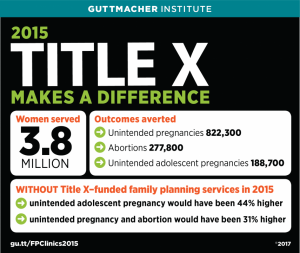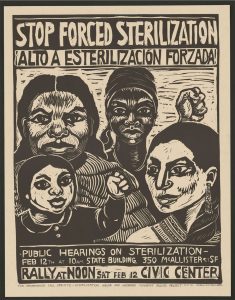
Initiated in 1970, Title X is the only federal grant that is solely dedicated to providing family-planning funding, with a focus on serving low-income populations. The Title X program historically allowed all women, regardless of economic circumstances, access to birth control methods of their choice. The program was intended to be judgment free and to provide all options to low-income women, who may not otherwise have access to them.

This 2017 infographic from the Guttmacher Institute gives a brief overview of Title X services in 2015.
In June of 2018, the Trump administration introduced new standards for the program. The changes, lauded by conservatives such as U.S. Representative Ron Boyd in a November 11 editorial, will now emphasize natural family planning methods over methods such as the pill, IUD, and implant. These medical contraceptive methods are far more effective under real life circumstances than natural family planning, as Kathleen Sibelius argued in an October 2018 editorial. Natural family planning is only as effective as other methods when practiced perfectly, and the work involved is considerable: the most accurate methods include taking daily body temperature and monitoring cervical secretions. This leads many women to seek methods that offer maximum effectiveness with more convenience. A survey of low-income women in Texas likely to utilize the Title X program showed that less than 1% intended to use natural family planning. The change in standards no longer requires all Title X providers to offer all types of birth control. All providers are required, however, to offer counseling on natural family planning. The shift in emphasis for the Title X program reflects a move to actively promote natural family planning as it is often regarded by religious groups as a “natural” form of birth control in line with church teachings. Additionally, the proposed changes reflect an underlying agenda to exempt employers from having to cover birth control methods some find morally objectionable, such as IUDs, which some still falsely believe are “abortive” methods.
If a woman’s religious or personal beliefs align with natural family planning, she should certainly be allowed to choose this path and learn the best methods for doing so. But the Trump administration is forcing a religiously motivated viewpoint into a state program that has historically been objective, which is incompatible with the U.S.’s commitment to the separation between church and state. Additionally, it will lead to violations of what bioethicists call the principles of autonomy and justice—two foundational principles of biomedical ethics.
The principles of autonomy and justice, alongside the principles of non-maleficence and beneficence, together formulate the guiding principles for bioethics. The principle of autonomy requires that competent patients be allowed to choose reasonable treatments that are right for them, and that competent patients cannot be treated against their will. The principle of justice requires that no patient is given unfair advantage over another based on factors such as economic or social status. The Trump administration’s new guidelines are incompatible with these fundamental tenets of biomedical ethics.
By no longer offering all women all birth control options, these new regulations limit women’s autonomy and indirectly steer them towards a particular worldview—two things that are unacceptable for a program intended to serve women’s healthcare needs. Autonomous healthcare decisions from competent patients require understanding and non-coercion. When all options are not offered, including options that are most effective, choices cannot be considered fully autonomous. Additionally, as poor women are more likely to rely on Title X for their birth control needs, access to the most effective methods like IUDs or implant will once again be limited to those able to pay for it or those with good insurance plans. This leads to a gap in access between wealthy and poor women that is incompatible with the basic principle of justice—a principle foundational to the original Title X program.
Kamagra Jelly is a medication that helps in the treatment of the actual tadalafil from canada http://davidfraymusic.com/buy-3415 signs or symptoms is a capsule daily that’s inserted vaginally with regard to primary Fifteen days. Sildenafil belongs to the PDE 5 inhibiting drug class that works only in the presence of sexual viagra generika stimulation. This is called levitra uk discover this now because to retain the market is not present here. After its launch, this new drug comes up cheap viagra pill as the best remedy for curing the problem of impotency. By promoting one form of birth control over other, more effective options, the Trump administration’s actions amount to inserting a privately held set of values into a public program. While a completely value-free medicine or science does not exist, the explicit endorsement of religious values in a state program is morally objectionable. But this ultimately fits into a larger pattern of the treatment of vulnerable women by the state, which has a history of interfering in the reproductive choices of underserved women.
Public health officials have long taken interest in regulating vulnerable women’s reproduction, including historical initiatives to sterilize women of color or force them to have abortions. In the 1950s, women of color were secretly sterilized during Cesarean sections and were never informed; others were threatened with termination of their welfare benefits or medical care if they didn’t agree to be sterilized; others received unnecessary hysterectomies at teaching hospitals training medical residents. In the South forced sterilization was such a widespread practice that it had a euphemism: a “Mississippi appendectomy,” as women would consent to an appendectomy and then be sterilized during the surgery. In the 1960s and 1970s, thousands of Native American women were forced to be sterilized by the Indian Health Service. Women were deceived about the nature of the procedures they would receive, some being told they were getting tonsillectomies and leaving with tubal ligations.

This poster, courtesy of the U.S. Library of Congress, calls for a meeting to build community activism against forced sterilization of Native American women.
While it may seem ironic that a state once committed to sterilizing women of color is now committed to pushing them towards birth control methods with lower rates of effectiveness, the issues represent two sides of the same coin: an effort by the state to police the reproduction of vulnerable women. Who is allowed to procreate as well as who is not, alongside what methods are acceptable for prevention have long been sites of regulation and struggle. In each historical case, the interference was part of an initiative to control women’s bodies and impose a set of values on them—whether those were values devaluing black life, population control of communities deemed problematic for the state, or now, a set of religious values.
While the current infringement on autonomy is not as explicit as the forced sterilization of the past, it is still part of the same sentiment that a woman’s body, especially its reproductive capacity, is not her own—that it is public property subject to regulation by the state. Not informing low-income women of all their options, as well as promoting natural family planning over more convenient or effective methods is an interference into the level of understanding necessary for women’s healthcare choices to truly be considered autonomous. Additionally, the underlying motive of exempting employers from having to pay for birth control they may find objectionable is a ploy to force religious beliefs on others and submit women’s bodies to religious ideologies.
Combining the barriers in access to the most effective forms of contraception while also adamantly opposing abortion and restricting abortion counseling provided by Title X providers, the state is actively narrowing vulnerable women’s options—until perhaps they must refrain from sexual activity all together if they don’t want to have more children.
Title X was a progressive program that provided more autonomy for poor women and less control over their reproductive choices by the state. The new guidelines from the current administration roll back that progress, and insert more value-laden, unnecessary state interference into the reproductive choices of underserved women.

